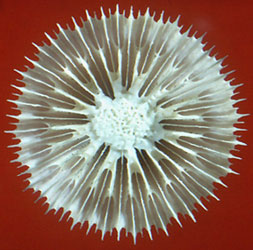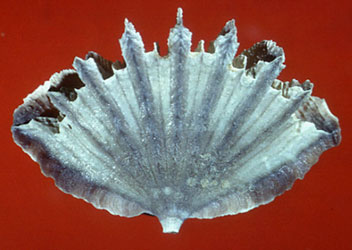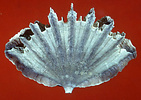Caryophylliina
Stephen D. Cairns- Caryophyllioidea
- Flabelloidea
- Volzeioidea

Introduction
The caryophylliines are known from the early Jurassic (180 million years ago) to the Recent, and occur in most marine environments to a depth of 3200 m. They are an extremely diverse group, consisting of 91 living genera and 457 living species (Cairns et al., 1999). Although some species form large colonies that may contribute to both shallow-water and deep-water reef/bank structure, most members of this suborder are small (less than 30 mm) and inconspicuous, occurring in cryptic shallow-water environments or in cold (as low as -1°C), dark, deep waters. Although several other scleractinian families occur in deep water (e.g., Dendrophylliidae, Micrabaciidae, Fungiacyathidae), the caryophylliines have been the most successful in exploiting the deep-sea realm. Because many occur below the euphotic zone or cryptically in shallow water, most species are azooxanthellate (do not contain symbiotic unicellular dinoflagellates) and therefore rarely attain a large size.
Characteristics
Suborders within the Scleractinia are distinguished by the structure of their septa. The septa of the caryophylliines are lamellar, composed of one fan system of simple, very small trabeculae (minitrabeculate), resulting in a smooth or nearly smooth inner margin (Vaughan and Wells, 1943; Wells, 1956).
The superfamilies within this suborder are characterized by the structure of their walls (theca). The most primitive of the three superfamilies, the Volzeioidea, have an exclusively epithecate wall (see Stolarski, 1995, 1996); that of the Flabelloidea is marginothecate; and that of the Caryophyllioidea is septo- or parathecate. In the latter two cases a nontrabecular deposit of epitheca or textura may be added to the exterior of the corallum (Stolarski, 1995).
Discussion of Phylogenetic Relationships
No phylogenetic analysis has been performed on the suprageneric taxa of the Caryophylliina; however, Stolarski (1995, 1996), Romano and Palumbi (1996), and Romano and Cairns (2000) are currently investigating and reassessing the higher level relationships in the suborder by using characteristics of the corallum microstructure and DNA sequencing, respectively (see Scleractinia branch page). Roniewicz and Morycowa (1993) and Veron (1995: 110) should also be consulted for more recent, non-cladistic evolutionary trees of all scleractinian families.
Classification
The higher classification of the suborder Caryophylliina is in a state of flux as more information is being discovered through microstructural and molecular analyses. Stolarski (1996, 2000) has best summarized the conflicting morphological characters, which resulted in two fairly different classification hypotheses for the superfamilies and families of the caryophylliines, which are both different from the classification presented here. In general, we agree with he work of Stolarski (2000), and, in general, adopt his "Hypothesis A", but with some modifications that reflect a more traditional view. Thus, we continue to recognize the superfamily Flabelloidea and place the Guyniidae in that superfamily, but we do accept his new family Stenocyathidae, which he places in the superfamily Caryophyllioidea, and his new family Schizocyathidae, which he places in the superfamily Volzeioidea.
References
Cairns S. D., B. W. Hoeksema, and J. van der Land. 1999. Appendix: List of Extant Stony Corals. Attol Research Bulletin, 459:13-46.
Romano, S. L. and S. R. Palumbi. 1996. Evolution of scleractinian corals inferred from molecular systematics. Science, 271: 640-642.
Romano, S. L. and S. D. Cairns. in press. Molecular Phylogenetic Hypotheses from the Evolution of Scleractinian Corals. Bulletin of Marine Science.
Roniewicz, E. and E. Morycowa. 1993. Evolution of the Scleractinia in the light of microstructural data. Courier Forschungsinstitut Senkenberg, 164: 233-240.
Stolarski, J. 1995. Ontogenetic development of the thecal structures in caryophylliine scleractinian corals. Acta Palaeontologica Polonica, 40: 19-44.
Stolarski, J. 1996. Gardineria -- a scleractinian living fossil. Acta Palaeontologica Polonica, 41: 339-367.
Stolarski, J. 2000. Origin and phylogeny of Guyniidae (Scleractinia) in the light of microstructural data. Lethaia, 33: 13-38.
Vaughan, T. W., and J. W. Wells. 1943. Revision of the suborders, families, and genera of the Scleractinia. Geological Society of America, Special Papers, 44: 363 pp.
Veron, J. E. N. 1995. Corals in Space and Time. 321 pp. UNSW Press, Sydney.
Wells, J. W. 1956. Scleractinia. Pp. F328-F444 In: Moore, R. C (editor) Treatise on Invertebrate Paleontology, Part F: Coelenterata. University of Kansas Press, Lawrence.
Title Illustrations

| Scientific Name | Deltocyathus rotulus |
|---|---|
| Location | off Sabah, Borneo (depth 871 m) |
| Specimen Condition | Dead Specimen |
| Body Part | skeleton |
| View | Calicular view |
| Size | Diameter of calice 30 mm |
| Image Use |
 This media file is licensed under the Creative Commons Attribution-NonCommercial License - Version 3.0. This media file is licensed under the Creative Commons Attribution-NonCommercial License - Version 3.0.
|
| Copyright |
© 2002
Stephen D. Cairns

|
| Scientific Name | Flabellum deludens |
|---|---|
| Location | Philippines (depth 289 m) |
| Specimen Condition | Dead Specimen |
| Body Part | skeleton |
| View | side view |
| Size | Width of corallum 45 mm |
| Image Use |
 This media file is licensed under the Creative Commons Attribution-NonCommercial License - Version 3.0. This media file is licensed under the Creative Commons Attribution-NonCommercial License - Version 3.0.
|
| Copyright |
© 2002
Stephen D. Cairns

|
About This Page
Creation of this page was supported by US National Science Foundation grants DEB95-21819 and DEB 99-78106 (in the program PEET - Partnerships to Enhance Expertise in Taxonomy) to Daphne G. Fautin, grant DEB99-78086 (in the program PEET) to Stephen D. Cairns, and grant OCE 00-03970 (in NOPP, the National Oceanographic Partnership Program) to D.G.F. and Robert W. Buddemeier.Technical assistance was rendered by Adorian Ardelean.
Stephen D. Cairns

Smithsonian Institution, Washington, D. C., USA
Correspondence regarding this page should be directed to Stephen D. Cairns at
cairnss@si.edu
Page copyright © 2002 Stephen D. Cairns
 Page: Tree of Life
Caryophylliina.
Authored by
Stephen D. Cairns.
The TEXT of this page is licensed under the
Creative Commons Attribution-NonCommercial License - Version 3.0. Note that images and other media
featured on this page are each governed by their own license, and they may or may not be available
for reuse. Click on an image or a media link to access the media data window, which provides the
relevant licensing information. For the general terms and conditions of ToL material reuse and
redistribution, please see the Tree of Life Copyright
Policies.
Page: Tree of Life
Caryophylliina.
Authored by
Stephen D. Cairns.
The TEXT of this page is licensed under the
Creative Commons Attribution-NonCommercial License - Version 3.0. Note that images and other media
featured on this page are each governed by their own license, and they may or may not be available
for reuse. Click on an image or a media link to access the media data window, which provides the
relevant licensing information. For the general terms and conditions of ToL material reuse and
redistribution, please see the Tree of Life Copyright
Policies.
- First online 28 October 2002
Citing this page:
Cairns, Stephen D. 2002. Caryophylliina. Version 28 October 2002. http://tolweb.org/Caryophylliina/19161/2002.10.28 in The Tree of Life Web Project, http://tolweb.org/











 Go to quick links
Go to quick search
Go to navigation for this section of the ToL site
Go to detailed links for the ToL site
Go to quick links
Go to quick search
Go to navigation for this section of the ToL site
Go to detailed links for the ToL site